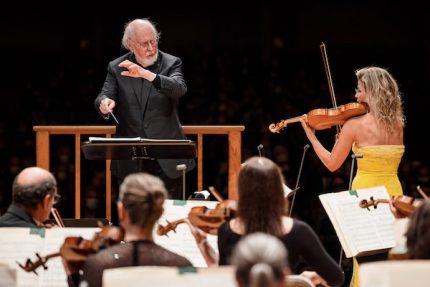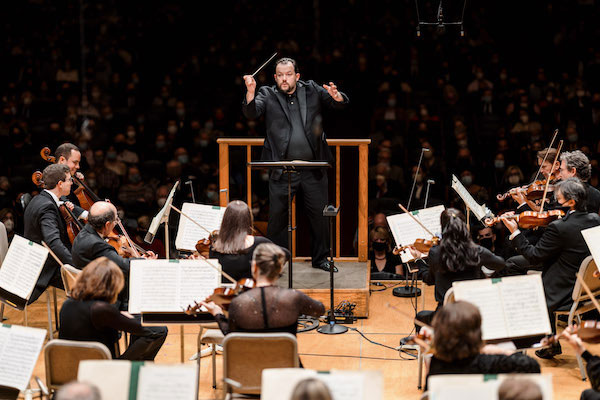Boston Symphony Orchestra returns for a grand reopening with friends

Sometimes the moment calls for boldness, sometimes restraint. On Thursday night, the Boston Symphony Orchestra, performing before a live audience at Symphony Hall for the first time in 568 days, went for a little bit of both.
It proved a wise choice. Thursday’s program, jointly led by music director Andris Nelsons and composer/conductor John Williams, was a quintessential BSO affair.
On the one hand, it tapped the ensemble’s storied history. Ludwig van Beethoven’s Consecration of the House Overture, which began the night, opened the orchestra’s inaugural season in 1881. Belá Bartók’s Concerto for Orchestra, which closed it, was written for the BSO and premiered at Symphony Hall in 1944.
In between, the evening brought together two of the institution’s greatest friends – violinist Anne-Sophie Mutter and Williams – for the local premiere of a substantial new piece, the latter’s Violin Concerto no. 2.
Though best known for his film scores, Williams has also crafted a substantial body of concert music. Broadly speaking, the latter can be more abstracted in tone and less expressively affecting than his commercial work.
Not so his Second Violin Concerto. Written for Mutter and premiered by her in July at Tanglewood, it’s a magisterial piece, full of bold contrasts of mood, textures, dynamics, and colors. The score’s points of reference—to jazz, popular song, the cinema, and the 20th-century canon—are discreet, its orchestration luminous.
The opening “Prologue” is both the longest and most diffuse of the concerto’s four movements. But its divergent structure is held together by recurring, pseudo-improvisatory turns for violin and harp, as well as fiery, toccata-like episodes for the soloist and some soaring melodic lines in the orchestra.
While the “Prologue” is often tempestuous, the second movement, “Rounds,” is more subdued. Here, Williams’ writing is vaguely Impressionistic—in outer thirds, the solo line dances lyrically over a hazy bed of lush woodwind sonorities. Things take a more reflective turn in the probing central section.
“Rounds” is followed by a lusty, stuperous waltz, titled “Dactyls.” With its tipsy, insistent solo lines, snarling, muted brass interjections, and a wild, culminating trio for violin, harp, and timpani, one is never quite sure if the music’s aim is more to amuse or to menace.
The finale, though, builds to a consolatory apotheosis. In it, searching, meditative figures are passed between orchestra and soloist; they’re finally resolved in a touching reprise of the second movement’s introspective second theme.
Suffice it to say, the whole piece is tailor-made for Mutter, whose rich tone, flexible vibrato, pristine intonation, penchant for expressive swoops, and evident love of jazz are all put through their paces. Her account of the solo part Thursday was intensely focused but never lost sight of the music’s broader, expressive aims.
Leading the BSO, Williams drew blazing colors from the orchestra. Calling it “really a treat” to be back at Symphony Hall, he led Mutter and the ensemble in a new arrangement of the “Love Theme” from his 1972 score to Robert Altman’s The Long Goodbye as an encore.
Nelsons conducted the rest of the night’s program.
Beethoven’s Consecration of the House Overture was plush-toned and spirited, though somewhat unbalanced: what sounded like exceptionally blended woodwind playing in the majestic introduction was too often covered by overbearing brasses and strings.
No such issues emerged in Thursday’s Concerto for Orchestra.
Indeed, Nelsons’ reading was conspicuous for its songful focus, especially in the first and third movements. True, this approach cost the music some degree of tension, especially in that first movement.
But it sounded gorgeous. What’s more, this was a texturally-exceptional Concerto for Orchestra: the duets and trios in “Giuoco delle coppie” were lucid. Woodwinds figures swirled eerily in the “Elegie.” The “Intermezzo’s” Shostakovich parody packed plenty of snark, while the finale’s fugal textures bristled.
The program will be repeated 8 p.m. Saturday at Symphony Hall. bso.org; 888-266-1200
Posted in Performances



